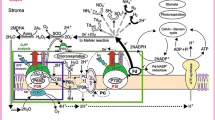Summary
Illumination of barnacle (Balanus amphitrite) photoreceptors is known to increase the membrane permeability to sodium and Ca2+ ions resulting in a depolarizing receptor potential. In this report, we show that lanthanum (La3+), a known inhibitor of Ca-binding proteins, reversibly eliminates the receptor potential of barnacle photoreceptors when applied to the extracellular space. Similar reversible elimination of the light response was obtained by removing extracellular Ca2+ by application of the calcium chelating agent EGTA. Iontophoretic injection of Ca2+, but not K+ into the cells protected both the transient and the steady-state phases of the receptor potential from elimination by EGTA while only the transient phase was protected in the presence of La3+. The EGTA experiments suggest that internal Ca2+ is necessary for light excitation of barnacle photoreceptors while the La3+ experiments suggest that La3+-sensitive inward current is necessary to maintain excitation during prolonged light.
Similar content being viewed by others
Abbreviations
- EGTA:
-
ethylenglyol-bis-(β-aminoethylether) N, N, N1, N1-tetraacetate
- BAPTA:
-
bis-(0-aminophenoxy)-ethane-N, N, N1, N1-tetraacetic acid
- DMSO:
-
dimethyl sulfoxide
- trp:
-
transient receptor potential
- nss:
-
no steady state
- ASW:
-
artificial sea water
References
Barash S, Suss E, Stavenga DG, Rubinstein CT, Selinger Z, Minke B (1988) Light reduces the excitation-efficiency in the nss mutant of the sheep blowfly Lucilia. J Gen Physiol 92: 307–330
Bolsover SR, Brown JE (1985) Calcium, an intracellular messenger of light adaptation also participates in excitation of Limulus photoreceptors. J Physiol 364:381–393
Brown HM, Rydqvist B (1990) Dimethyl sulfoxide elevates intracellular Ca2+ and mimics effect of increased light intensity in a photoreceptor. Pflügers Arch 415: 395–398
Brown HM, Hagiwara S, Koike H, Meech R (1970) Membrane properties of a barnacle photoreceptor examined by the voltage clamp technique. J Physiol (Lond) 208:385–413
Brown HM, Rydqvist B, Moser H (1988) Intracellular calcium changes in Balanus photoreceptors. A study with calciumselective electrodes and Arsenazo III. Cell Calcium 9: 105–119
Brown JE (1986) Calcium and light adaptation in invertebrate photoreceptors. In: Stieve H (ed) The molecular mechanism of photoreception. Dahlem Konferenzen, Springer, Berlin, pp 231–240
Brown JE, Blinks JR (1974) Changes in intracellular free calcium concentration during illumination of invertebrate photoreceptors. Detection with aequorin. J Gen Physiol 64:643–665
Brown JE, Lisman JE (1975) Intracellular calcium modulates sensitivity and time scale in Limulus ventral photoreceptors. Nature 258:252–254
Cosens DJ, Manning A (1969) Abnormal electroretinogram from a Drosophila mutant. Nature 224:285–287
Frank TM, Fein A (1991) The role of inositol phosphate cascade in visual excitation of invertebrate microvillar photoreceptors. J Gen Physiol 97:697–723
Frankenhaeuser B, Hodgkin AL (1957) The action of calcium on electrical properties of squid axons. J Physiol 137:218–244
Hardie RC, Minke B (1992) The trp gene is essential for a light-activated Ca2+ channel in Drosophila photoreceptors. Neuron (in press).
Hillman P, Hochstein S, Minke B (1972) A visual pigment with two physiologically active stable states. Science 175:1486–1488
Hochstrate P (1989) Lanthanum mimics trp photoreceptor mutant of Drosophila in blowfly Calliphora. J Comp Physiol A 166:179–188
Howard J (1982) Kinetics and noise of transduction in insect photoreceptors. PhD Thesis, Australian National University, Canberra, Australia, pp 56–70
Howard J (1984) Calcium enables photoreceptor pigment migration in a mutant fly. J Exp Biol 113:471–475
Koike H, Brown HM, Hagiwara S (1971) Hyperpolarization of a barnacle photoreceptor membrane following illumination. J Gen Physiol 57:723–737
Lisman JE, Brown JE (1972) The effect of intracellular iontophoretic injection of calcium and sodium ions on the light response of Limulus ventral photoreceptors. J Gen Physiol 59:701–719
Meech WR, Brown HM (1976) Invertebrate photoreceptors: A survey of recent experiments on photoreceptors from Balanus and Limulus. In: Spenser Davies P (ed) Perspective in experimental biology, Vol 1, Zoology. Pergamon Press, Oxford, pp 331–351
Miledi R (1971) Lanthanum ions abolish the “calcium response” of nerve terminals. Nature 229:410–411
Minke B (1982) Light-induced reduction in excitation efficiency in the trp mutant of Drosophila. J Gen Physiol 79:361–385
Minke B, Wu C-F, Pak WL (1975) Induction of photoreceptor voltage noise in the dark in a Drosophila mutant. Nature 258:84–87
Muijser H (1979) The receptor potential of retinular cells of the blowfly Calliphora: the role of sodium, potassium and calcium ions. J Comp Physiol 132:87–95
Nathan RD, Kanai K, Clark RB, Giles W (1988) Selective block of calcium current by lanthanum in single bullfrog atrial cells. J Gen Physiol 91:549–572
Payne R, Corson DW, Fein A (1986) Pressure injection of calcium both excites and adapts Limulus ventral photoreceptors. J Gen Physiol 88:107–126
Payne R, Walz B, Levy S, Fein A (1988) The localization of calcium release by inositol trisphosphate in Limulus photoreceptors and its control by negative feedback. Phil Trans R Soc Lond B 320:359–379
Stieve H, Bruns M (1980) Dependence of bump rate and bump size in Limulus ventral nerve photoreceptor on light adaptation and calcium concentration. Biophys Struct Mech 6:271–285
Stieve H, Bruns M, Gaube H (1976) The action of lanthanum ions in the eyes of Astacus and Limulus: access to the photoreceptor membrane and influence on the electrical response. Berichte der Kernforschungsanlage Jülich, Jül-1306, 1–58
Suss E, Barash S, Stavenga DG, Stieve H, Selinger Z, Minke B (1989) Chemical excitation and inactivation in photoreceptors of the fly mutants trp and nss. J Gen Physiol 94:465–491
Suss-Toby E, Selinger Z, Minke B (1991) Lanthanum reduces the excitation efficiency in fly photoreceptors. J Gen Physiol 98:848–868
Walz B (1992) Enhancement of sensitivity in photoreceptors of the honeybee drone by light and by calcium. J Comp Physiol (in press)
Wendt Gallitelli MF, Isenberg G (1985) Extra- and intracellular lanthanum modified calcium distribution, inward currents and contractility in guinea pig ventricular preparation. Pflügers Arch 405:310–322
Yau K-W, Nakatani K (1984) Electrogenic Na-Ca exchange in retinal rod outer segment. Nature 311:661–663
Author information
Authors and Affiliations
Rights and permissions
About this article
Cite this article
Werner, U., Suss-Toby, E., Rom, A. et al. Calcium is necessary for light excitation in barnacle photoreceptors. J Comp Physiol A 170, 427–434 (1992). https://doi.org/10.1007/BF00191459
Accepted:
Issue Date:
DOI: https://doi.org/10.1007/BF00191459




